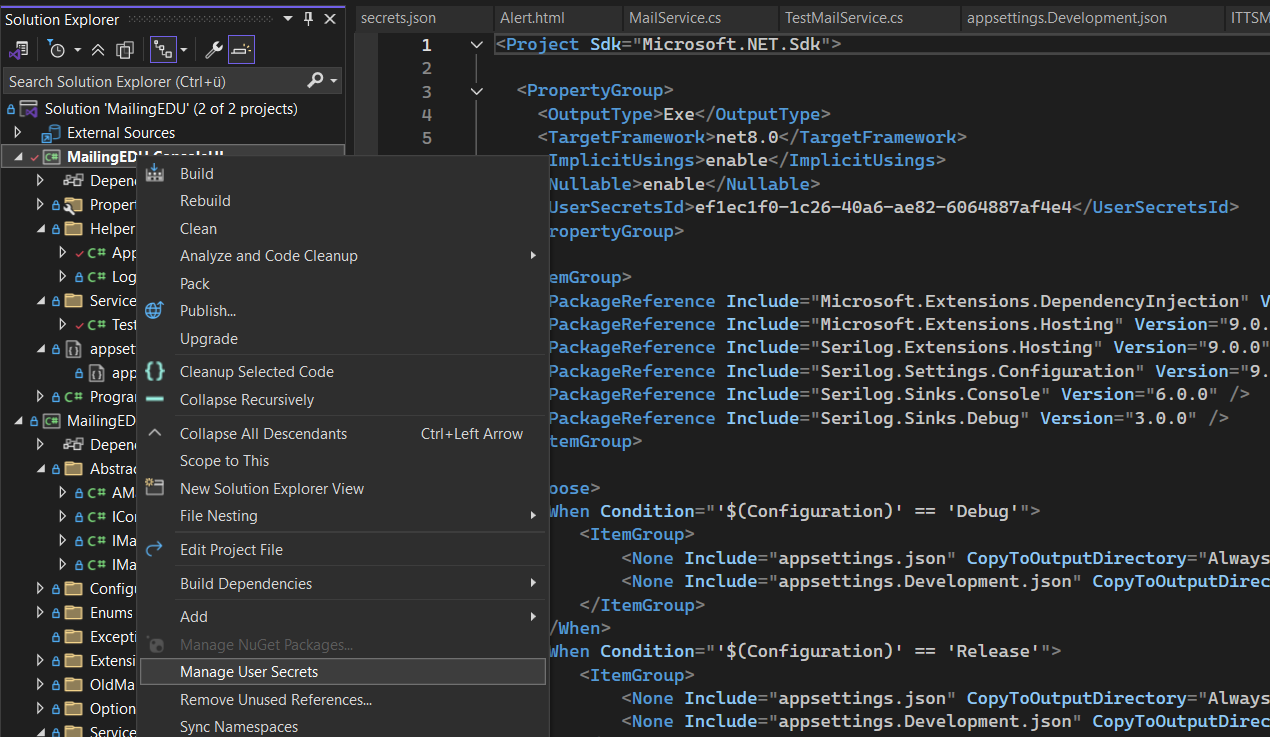Appsettings User Secrets
User Secrets provide a way to override appsettings values locally during development. They are stored outside of your project directory (typically in the user profile’s AppData folder) and are never committed to source control, ensuring that sensitive or developer-specific data remains private.
When configured correctly, secrets will override values from both appsettings.json and appsettings.{Environment}.json, such as appsettings.Development.json.
secrets.json Storage
To use User Secrets, right-click on your project and select “Manage User Secrets”:
This creates a secrets.json file outside your project and adds a UserSecretsId to your .csproj file.
You can now define any configuration values you want to override. Partial overrides are also supported:
Loading and Configuring in Code
To load the secrets into your application, extend your configuration builder with a call to builder.AddUserSecrets<Program>();. You can also replace Program with a dummy class (e.g.,UserSecretsMarkerClass) as long as it is part of the main project.
The key point is that the class must be discoverable so Visual Studio can correctly resolve the associated UserSecretsId.
Example Code of my AppsettingsHelper class that gets called in the beginning of the app:
1
2
3
4
5
6
7
8
9
10
11
12
13
14
15
16
17
18
19
20
21
22
23
24
25
26
/// <summary>
/// Builds and caches the configuration. Reloads only if explicitly reset.
/// </summary>
public static IConfiguration GetConfiguration()
{
if (_configuration != null)
return _configuration;
var envVarName = GetEnvVarName();
var environment = string.IsNullOrWhiteSpace(envVarName)
? null
: Environment.GetEnvironmentVariable(envVarName);
var builder = new ConfigurationBuilder()
.SetBasePath(Directory.GetCurrentDirectory())
.AddJsonFile("appsettings.json", optional: false, reloadOnChange: true);
if (!string.IsNullOrEmpty(environment))
builder.AddJsonFile($"appsettings.{environment}.json", optional: true, reloadOnChange: true);
builder.AddUserSecrets<Program>();
builder.AddEnvironmentVariables();
_configuration = builder.Build();
return _configuration;
}
secrets.json file:
1
2
3
4
5
6
{
"Mailing": {
"UserName": "SomeSecretUser",
"Password": "SomeSecretPassword"
}
}
These secrets then overwrite the data configured for the service with the call for configuration in Dependency Injection Service extension in the MailServiceOptions object.
MailingServiceCollectionExtensions example
1
2
3
4
5
6
7
8
9
10
public static class MailingServiceCollectionExtensions
{
public static IServiceCollection AddMailer(this IServiceCollection services, IConfiguration configuration)
{
services.Configure<MailServiceOptions>(configuration.GetSection(ConfigurationSections.Mailer));
services.AddTransient<IMailService, MailService>();
return services;
}
}
Debug preview with overwritten data:


